Dear readers, I'm afraid I owe you an apology. Last week, I criticized members of the media for their coverage of Pope Francis's meeting with President Obama. Before the meeting, some commentators suggested that the pope was planning to confront the president about his support for the contraception mandate and abortion rights. And after the meeting others contrasted the Vatican's press release with Obama's recollections at a press conference. I wrote:
There's nothing perplexing about the differences between a formal Vatican statement and a president's ad libbed remarks to the press. The Vatican's news release was never going to contain revealing language about the pope's emotional response to meeting Obama. It was never going to go on at any length or in any detail about what they discussed. When Benedict XVI met with George W. Bush in 2008, for example, it was, yes, awesome, but the joint statement of the Holy See and the White House didn't exactly describe the visit in florid terms. That's just how these things go.
How mistaken I was. If only I'd waited a couple of days, I would have had my illusions dispelled by George Weigel. He, too, takes issue with pre-meeting speculation, noting that some of it caused "confusion" that was "instructive on several counts." According to Weigel, that shows just how "poorly equipped" most of the media is "to cover the Vatican and its ways." But those ways are right in Weigel's wheelhouse, so he attempts to sort through them for the rookie Vaticanista, beginning where so many of Catholicism's riches lie: symbolism, especially photographic symbolism, particularly photographic symbolism that entails the appearance of popes with other world leaders.
Pope Francis conducted his conversation with President Obama across a desk — a stage-setting exercise on the Vatican’s part that one canny media veteran thought “a tad aggressive” and another observer said resembled a school principal having a firm talk with a recalcitrant student.
I hadn't considered that. But now that Weigel mentions it, I see his point. How many office-hours have I spent sitting across the desk from a professor who offered firm rebuttals to my half-baked musings on this or that theological problem? Of course, I may have been too arrogant to understand how thoroughly my incompetence had been exposed. But I had no illusions about who had authority and who did not.
See for yourself:

There you have it. On one side: Leader of the world's 1.2 billion Catholics, chosen by the College of Cardinals to serve for the rest of his life, whose approval ratings are the envy of elected officials across the globe. On the other: president of a country of 320 million, half of whom aren't happy with his leadership, and a tiny fraction of whom cares enough to vote. Could Pope Francis have been any clearer? When a pope places a desk between a world leader and himself, it's obvious to anyone who knows anything about the Catholic Church that he is signaling the distance between the two--if not his outright disapproval.
Just look at how Pope John Paul II handled talks with his collaborator--or at least pen pal--Ronald Reagan:

Wait, that can't be right. Let's try again. Here's a photo of Benedict XVI and George W. Bush, who, we know, agreed on the non-negotiables:

Well, now I'm beginning to wonder whether Weigel really is keyed in to the nuances of papal photography. He has more to say on the subject. Quite a bit, actually:
Then there were the first photos released by the Holy See. Pope Francis is loath to be turned into a stage prop for politicians, and so he generally avoids offering photographers smiling shots when he is with heads of state or government. And while the photo used on the front page of the March 28 Washington Post showed Francis smiling at what appears to have been an Obama witticism, the first photo of the two men released by the Vatican offered a different image and message: a rather stern-looking pope beside a smiling president who seemed unaware of his conversation partner’s wish not to be used. The same was true of the official photo of the pope with the presidential party. Most of the Americans (including POTUS but not, instructively, Susan Rice) were cheerfully, almost blithely, grinning; Pope Francis, with guarded eyes and a flat expression, seemed discinclined to join the jollity.

All right, maybe Weigel has a point here. The pope doesn't look too thrilled to be standing next to the contraceptor-in-chief, does he?
But the Washington Post wasn't the only outlet to side with the White House by distributing the happiest-clappiest shots of pope and president. The L.A. Times and the New York Times ran with photos depicting a pope clearly working hard to mask his disdain for Obama's domestic agenda. Even a local news station captured a telling moment, when the pope gave Obama a copy of his apostolic exhortation, Evangelii Gaudium.
 Weigel translates that papal message too: "The pope offered the president...Evangelii Gaudium (The Joy of the Gospel), as if to say, 'You and your people have been making a number of suggestions about who I am and what I’m about; here is who I really am, and here is the central theme of my pontificate: a call to the Church to consider itself in permanent mission, bringing the divine mercy to the world.'" Obviously Francis intended Obama to focus on the passages Weigel highlights, in which the pope defends the unborn. It's written all over his face.
Weigel translates that papal message too: "The pope offered the president...Evangelii Gaudium (The Joy of the Gospel), as if to say, 'You and your people have been making a number of suggestions about who I am and what I’m about; here is who I really am, and here is the central theme of my pontificate: a call to the Church to consider itself in permanent mission, bringing the divine mercy to the world.'" Obviously Francis intended Obama to focus on the passages Weigel highlights, in which the pope defends the unborn. It's written all over his face.
Of course, Francis would never come out and say such a thing. But as Weigel notes, it's what the Vatican didn't say that speaks volumes. Its news release was, according to Weigel, "striking in its terseness." Here's the part about what they discussed:
In the context of bilateral relations and cooperation between Church and State, there was a discussion on questions of particular relevance for the Church in that country [the United States], such as the exercise of the rights to religious freedom, life, and conscientious objection, as well as the issue of immigration reform. Finally, the common commitment to the eradication of trafficking of human persons in the world was stated.
I know, difficult to understand--and somewhat more oblique than, say, John Paul II's comments to George W. Bush in the run-up to the Iraq war. But Weigel is on this too. "The Holy See underscored that it was very concerned about the HHS mandate and its impact on the religious freedom of all, about the administration’s radical pro-abortion policies, and about the effects of all this on the civil and legal position of Americans of conscience."
Now, you shouldn't fault yourself for not being able to read these tea leaves as clearly as Weigel can. He knows more than your average observer of things Catholic. For example, did you know that Pope Francis's "insistence on the reality of Satan" stems from his "repeated references to Robert Hugh Benson’s 1907 dystopian novel, Lord of the World"? But don't rush out and buy it, Weigel cautions--it's not exactly "(cue gentle cough behind hand) great literature"--he can interpret that for you too.
For like the Antichrist figure in Signorelli’s Last Judgment fresco cycle in the Orvieto cathedral, Benson’s Antichrist is an attractive man: intelligent, urbane, seemingly sympathetic to suffering, a mesmerizing public speaker.
Sound familiar?
Yet beneath that attractive façade is a demonic figure obsessed with power and determined to cast the God of the Bible out of human affairs: a man who is an instrument of Satan, the great deceiver and, as Jorge Mario Bergoglio not infrequently refers to him, the “father of lies.”
In other words, dear readers, don't be fooled. Not by White House spin doctors. Not by the Vatican statement itself. Sometimes it takes a seasoned professional to decode complex Catholic messages, to tell you which words of a photo's thousand matter, or which parts of a papal encyclical you can safely dismiss.
Because if anything is clear from Weigel's long career commenting on papal comings and goings, it's this: If you bring the signal, he'll bring the noise.
Please email comments to [email protected] and join the conversation on our Facebook page.
Share
Previous Story
Who Comes to the Dinner?
Next Story
How to Read the Old Testament


